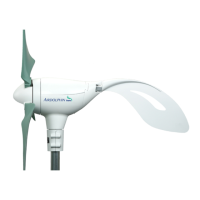
Do you have a question about the Zephyr Airdolphin Pro Z-1000 - 48 and is the answer not in the manual?
| Rated Power Output | 1000 W |
|---|---|
| Rated Voltage | 48 VDC |
| Start-up Wind Speed | 2.5 m/s |
| Blade Material | Fiberglass |
| Generator Type | Permanent Magnet |
| Tower Height Recommendation | 12 m |
| Model | Zephyr Airdolphin Pro Z-1000 - 48 |
Crucial safety instructions and warnings to read before proceeding with product use.
Explains symbols used for Danger, Warning, and Caution to ensure safe operation.
Details essential safety protocols, including DANGER, WARNING, and CAUTION alerts.
Provides further warnings and cautions regarding electrical proximity, temperature, and modifications.
Highlights advanced technologies like low mass, new rudder, rotor design, and noise reduction.
Details power management, continuous output, safety control, and high-efficiency operation.
Describes the heavy-duty generator and the upcoming internet connectivity system.
Focuses on the aesthetic design inspired by nature, winner of the Good Design Award 2005.
Provides detailed technical specifications, including dimensions, materials, and performance metrics.
Illustrates the turbine's power generation performance relative to wind speed.
Ensures safe installation by considering wind, obstacles, and human proximity.
Addresses potential public nuisance from noise and shadows from the wind turbine.
Recommends placement for highest wind speed and unobstructed passage for optimal output.
Lists and illustrates all individual parts of the Airdolphin system for identification.
Instructions for checking all parts against the list after opening the package.
Outlines the main steps for assembling the Airdolphin unit, including critical safety.
Detailed instructions for connecting the pole to the body (yaw shaft) and securing the yaw shaft cover.
Procedure for attaching the tail section to the main body, including screw plug installation.
Guide for attaching the three blades to hub 1, ensuring correct alignment and secure fitting.
Instructions on how to fit the C-ring and attach the assembled rotor to the body's shaft.
Covers final rotor fixation steps: hexagonal nut, gap verification, nose cone attachment, and checks.
Important notes before connecting, including battery type and polarity.
Guidance on the recommended length and specifications for extension cables.
Recommendation for installing a D.P.D.T. switch for safety and emergency stop functionality.
Details on connecting the output cable extension, including power and data cables.
Provides a typical wiring configuration example for the Airdolphin system.
Visual representation of a typical off-grid standalone system connection.
Describes the function of the indicator LED on the body for system status.
Table detailing operating modes, indicator status, causes, and operations.
General guidance on selecting compatible batteries, towers, and cables.
Specifies recommended battery types and configurations for off-grid systems.
Details essential specifications for the mounting tower for safety and performance.
Provides guidance on selecting appropriate cable diameters based on distance.
Advice on choosing suitable DC-AC inverters for converting generated power.
Recommended daily visual checks to ensure the system is operating correctly.
Critical warnings and cautions regarding part replacement and system care.